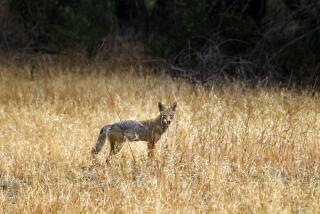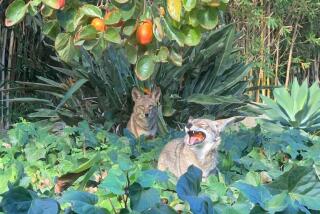Letting the Fur Fly Over Fate of the Coyote
- Share via
My suggestion that “coyotes have to eat too” has inspired the wrath of reader Bruce Lowry, who complains that Hitler could have justified the Third Reich with that kind of slogan.
“Of course coyotes do not have to eat!” he insists. “Coyotes have a perfectly logical alternative: They can become extinct! They can go live in the museum with the dinosaurs!
“Face up to it, you sentimental slob. Coyotes have had their day. They had their chance along with the puppy doggies to come in to the cowpoke’s campfire and fetch sticks and lick hands. They turned it down for the sport of howling at the moon.”
That coyotes did not choose to become domesticated is one of the things I like about them. They have managed to survive within the city limits and still retain their wild ways.
We still see one or two occasionally on Mt. Washington, only five miles from City Hall; we often hear them howling in packs at night. It is remarkable that they live and prosper within a ring of freeways.
They are widely misunderstood and despised. It is true that coyotes will eat rabbits and chickens, and even cats; but the stories that they have been known to carry off small children are, I suspect, myths. That they may sometimes be rabid is probably true; it is true also of dogs and cats.
According to John Hunt, in his book “A World Full of Animals,” some American Indians believe that when man and animals begin to pass into oblivion, the coyote will be the last survivor.
The name coyote comes from the Aztec coyotl ; its scientific name, Canis latrans means barking dog. The coyote resembles a medium-sized dog, with the narrow, pointed nose of a fox. His coat is a coarse grizzled buff-gray with black-tipped hairs that sometimes make the animal look black. The “raccoon” coats fancied by young men in the ‘20s were often coyote, a use that made life even more hazardous for this outcast creature.
When I was a small boy I used to be driven from Bakersfield to the small farm center of Shafter to visit my cousin Annabelle. Along the road from the highway to Shafter, about eight miles, thousands of coyote pelts would be strung up on miles of barbed wire fences. It was a graphic sign of the disfavor in which this animal was held.
That the coyote has managed to survive such mass slaughter is another mark of its durability. They survive because they are intelligent, omnivorous, prolific and adaptable. Hunt notes that in 1962 the state spent $90,195 in bounties for killing coyotes, while the coyotes killed only $3,501 worth of sheep in the same period.
Coyotes may mate for life, but parents tolerate their offspring only from spring, when they are born, to fall. The coyote being so prolific, this makes them difficult to keep in zoos, since interfamily clashes are frequent.
Probably because it holds its head and tail low when running, the coyote is thought of as “skulking.” A creature that skulks is regarded as devious, untrustworthy and predatory. Undoubtedly, the coyote is all of these, but it has a certain nobility of carriage too.
Los Angeles probably has more wildlife than any other big city. Our wooded hillsides and ravines offer a haven to such creatures as skunks, raccoons, opossums, deer and rattlesnakes as well as coyotes. There is no more enchanting moment in hillside life than when one opens a door or looks out a window and sees one of these creatures in his own back yard.
I will exclude the rattlesnake from these fond musings. Rattlesnakes are entitled to live too, of course, but I would rather not have one on my own premises. Still, they are natural enemies of rodents, for which few will have a kind word.
The truth is that the coyote, despite its feeding instincts, is an admirable animal, quite worthy of its place on the landscape; if the price of its survival is a few rats and rabbits, or even an occasional cat, how can we deny it its right to exist? Why should we put a bounty on its head and align our traps and guns against it?
Yes, indeed, coyotes have to eat too.
More to Read
Sign up for Essential California
The most important California stories and recommendations in your inbox every morning.
You may occasionally receive promotional content from the Los Angeles Times.













